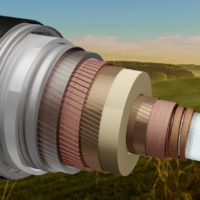Superconductivity is a fascinating state of matter characterised by the absence of electrical resistivity that particular materials exhibit when cooled below a certain critical, cryogenic temperature. Together with other unique properties, such as the ability to carry large currents and operate at extremely large magnetic fields, superconducting materials present innovative technological solutions towards accelerating the energy transition.
“The Energy Transition is an unavoidable global priority. We must decarbonise the economy by the second half of this century and tremendous challenges are ahead of us”, says Professor João Murta Pina, from NOVA University of Lisbon, who chairs the COST Action High-Temperature SuperConductivity for AcceLerating the Energy Transition.
Since high-temperature superconducting (HTS) materials were discovered in the 1980s, there has been sustained interest in exploiting their superior properties in a range of practical, next-generation applications across the electric power sector. HTS materials are able to enter the superconducting state above the temperature of (cheap and abundant) liquid nitrogen, they can carry higher currents in the presence of a magnetic field than other practical materials, and exhibit improved thermal and mechanical properties. These properties enable the development of technologies and devices that are more efficient with smaller footprints and reduced weight and/or offer unique and potentially disruptive solutions. These can be integrated into all aspects of the electric power systems – from generation to transmission and distribution, energy storage and end-use – to improve their safety, security, reliability, and sustainability and to accelerate decarbonisation efforts.
Continual advances in manufacturing techniques have resulted in the commercial availability of long lengths (km+) of high-quality HTS wire from several manufacturers around the world and this has improved technological readiness levels and the commercial attractiveness of such devices.
“Increasing distributed renewable generation, changing transportation paradigms, and improving energy efficiency are some of the foundations for the Energy Transition. A multitude of challenges requires a variety of solutions. HTS-based technologies can address all these major challenges, and thus have a role in the solutions.” – adds Prof. Pina.
However, despite all the potential benefits and successful demonstrators of numerous HTS technologies, they still lack mass penetration in the power system. Several reasons for this, as pointed out by industry, include concerns related to perceived high costs; uncertainty about the reliability of superconducting devices, including the cryogenic technology that underpins such technology; and the perception that only highly skilled professionals would be able to operate such technology. Other concerns relate to a lack of systematic knowledge about the design of HTS systems for the power grid and how to simulate their performance using standard software packages.
To tackle all of the above challenges and to bring superconducting power applications closer to a commercial reality, a diverse network of experts in academia and industry – from over 20 countries across Europe and beyond – have been brought together through a four-year COST Action network called Hi-SCALE, which stands for High-Temperature SuperConductivity for AcceLerating the Energy Transition (Hi-SCALE).
“We are excited and committed to train a new generation of experts – especially those from Inclusiveness Target Countries – who can evolve HTS technologies, bringing them to the real world to make an enormous contribution to future society” says Prof. Pina.
This COST Action aims at developing systematic approaches to create pathways between materials research and real-world devices and foster improved modelling and advanced computation paradigms. Methodologies and demonstrators will be provided to address industrial challenges and applications, as well as tools for the economic and sustainability assessment of HTS technologies.
Through the generous funding of the COST Association, this Action will enable us to make great strides towards turning the potential of HTS materials into proven and breakthrough-capable technologies that will be key assets for a sustainable world.
(1) Engineering and Physical Sciences Research Council (UK)
Photo:
Caption: Superconducting cables provide a low-loss solution for efficient transmission and distribution of electrical power
Credit: Courtesy of the Institute of Technical Physics, Karlsruhe Institute of Technology, Germany
